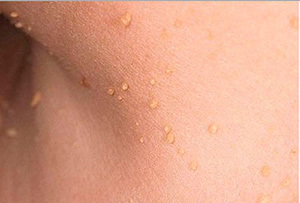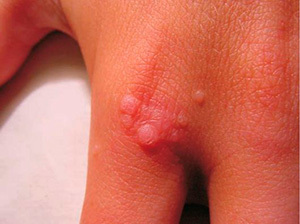
Papillomas or warts are the most common disease. The presence of growths on the skin is noted in 80% of the population. This defect is caused by the human papillomavirus (HPV). Neoplasms can occur in any part of the body: on the neck, arms, face, external genitals, as well as in the internal visceral organs. However, at first glance, this harmless neoplasm can degenerate into a malignant formation and cause melanoma - a skin cancer.
Papillomas are formed from the epithelium of the superficial skin (warts) and the mucous membranes of internal organs (condyloma). They can be of various shapes, for example round or clavicular, especially towering above the skin and have a characteristic color. Each wart has the same type of structure: a base formed from connective tissue (collagen and elastin, in the composition of loose fibrous tissue, giving elasticity to the stromal framework), and blood capillaries located in the center of the wart.
Why do small papillomas appear on the body
The only reason for any growth in the body is HPV damage, due to a weakened immune system. There are about 120 known types of viruses. Infection most often occurs after the inflammatory process. The activity of the HPV virus depends on the immune status and individual responses of the human body.
Minor damage to skin areas, multiple microtraumas, violation of the epidermal barrier allows the virus to penetrate into the upper layers of the skin. This virus does not circulate with the bloodstream, but lies directly in the dermis. Therefore, the incubation period is not less than 3 and not more than 5 months. This continues with latent symptoms. Only after 5 months will there be noticeable clinical changes. The double DNA helix, which is part of it, ensures a recurrence of disease, even after an immune response or clinical cure, because one DNA is retained in epidermal cells.
There are four main causes of virus infection:
- Contact and domestic reasons - physical contact (handshake) with carriers of this virus, as well as use of patient personal hygiene items.
- Suppressive action of the general and local immune system, due to the existing inflammatory process or constant stress.
- From mother to child (anogenital warts). It is transmitted at birth and has a high risk of development and a large area of spread.
- Sexual contact with HPV patients in 50% of cases.

Infection via the contact-household line ranks first in terms of the number of cases. The hands are the most exposed and unprotected parts of the body. Because of this, small papillomas often appear on the hands.
Papillomas are further divided into several morphological classifications.
Based on their size, there are: small and large papillomas.
Warts look like this:
- Ordinary- localized on the free belt of the upper limbs: the surface of the palms, knuckles, elbows, backs of the hands. The shape is round.
- Simple- found all over the body, more commonly located on the neck and arms. They have the appearance of gray bubbles rising above the skin.
- Pointed- looks like a comb. They are small and white in appearance, club shaped.
- Seborrheic keratosisare age-related warts. Keratin, does not carry a pathogenic character due to different origins.
- Thorns- the coarsest and most rigid Often large and high above the skin.
By location: plantar (hands and feet), flat (papillomas on the body), regular (hands), fleshy warts (on the plantar surface of the feet)
Etiology of warts: congenital and acquired.
Most often, small papillomas can appear among patients. And this type is able to form groups.
What is the danger of a small papilloma
The danger of small papillomas is that they are barely visible on the body and may appear unexpectedly. This increases the risk of contracting HPV.

If after skin contact you have minor warts, be sure to visit a dermatologist. A highly specialized doctor will be able to distinguish the type of papilloma and the period of its presence, which will be the basis for prescribing treatment.
Do not tear, do not try to get rid of small papillomas yourself, and even more so with the help of traditional methods. You can hurt yourself! Since benign neoplasms carry a risk of degeneration into oncology, the resulting growth should be discarded in the clinic.
Some types of human papillomavirus are highly oncogenic. And they can provoke not only skin cancer (melanoma), but also cancer of the cervix (in women) and ring of the anus (in men), the formation of polyps of internal organs.
Papilloma on the body, located in a place where friction increases or the damage must be removed immediately! To avoid pathology.
How to remove small papillomas using different methods
Since this defect occurs more frequently in women than in men, wart removal is mostly initiated by the patient. Even for no apparent reason. How to get rid of papilloma on the body?
Type of treatment:
- Use of drugs that affect the immune system. Immunomodulators and immunocorrectors, immunostimulants, and other drugs that are immunotropic, increase the immune response and normalize certain interfering links of the immune system.
- Use of intramuscular injections and rectal suppositories with an antiviral effect in combination with vitamins.
- Drugs are prescribed to increase the immune response, which stimulates the production of its own interferon.
- The use of herbs to strengthen the body in general.
Types of surgical treatment:
- Surgical excisionis the first method of removing papillomas. It is common among other types. Wart excision is done with all the underlying tissue. The effectiveness of this method is 65%, and the overall recurrence is about 30%. A side effect of surgical excision is scarring. This technique is used to remove papillomas that are localized in the lower extremities.
- Chemical coagulation- burns warts with chemicals. Uses 95% silver nitrate, 17% salicylic acid and cantharidin. The most potent is cantharidin. By penetrating into the lower layers of the skin and destroying the wart. Long and expensive method. The efficiency of this technique is around 80%.
Method for removing very small papillomas
How do I get rid of "minuscule" papillomas? In modern clinics, there are countless techniques to get rid of small warts without cosmetic defects.
If you intend to quickly and effectively get rid of that annoying growth all over your body, here are some of the best techniques for getting rid of the miniscule growth:
- Cryotherapy.Freezing with liquid nitrogen. The fastest and most affordable technique takes no more than 15 minutes. It is recommended to remove papillomas located on the face and neck.
- Laser destruction method.There are several types of lasers. The most popular are carbon dioxide lasers. The last healing occurred 7 days after surgery. Recommended for hard to reach warts.
- Photodynamic therapy for warts.Performed using a long wavelength of light. The most effective method (95%), the buildup will be easy to remove and no scar will remain.
Prevention of small growth
Preventing disease is always easier than healing! Let this slogan be your credit for life. In preventing the appearance of papillomas, it is important to lead a healthy lifestyle. Give up bad habits (smoking) for your health! Strengthen the immune system and start treatment on time, if needed. Relieve stress and get more rest. Try to eat right, get enough sleep, and spend time outdoors. Monitor your health, visit the clinic every year and have regular check-ups. If you suspect HPV or papilloma, contact your doctor immediately. Follow the rules of prevention and you will not care about any ailments.














































































